Eudocima homaena
Eudocima homaena is a moth of the family Erebidae first described by Jacob Hübner in 1816. It is found in the Indian subregion, Sri Lanka, Myanmar, Taiwan, the Nicobars, Peninsular Malaysia, Borneo, the Philippines and on Christmas Island.[1] It is a major pest on orange plants.[2]
| Eudocima homaena | |
|---|---|
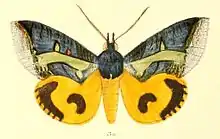 | |
| Female | |
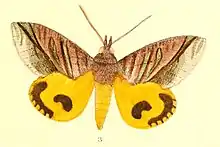 | |
| Male | |
| Scientific classification | |
| Domain: | Eukaryota |
| Kingdom: | Animalia |
| Phylum: | Arthropoda |
| Class: | Insecta |
| Order: | Lepidoptera |
| Superfamily: | Noctuoidea |
| Family: | Erebidae |
| Genus: | Eudocima |
| Species: | E. homaena |
| Binomial name | |
| Eudocima homaena (Hübner, 1816) | |
| Synonyms | |
| |
Description
Its wingspan is about 80 mm. Palpi with third joint long and spatulate at extremity. Forewings with apex not produced. Outer margin rounded. Forewings with non-crenulate cilia. Male has fulvous brown head and thorax. The collar, metathoracic tufts and tibia with an orange tinge. Head and collar with a purple bloom. Abdomen orange. Forewings olive green, suffused with purplish red-brown and striated with rufous. Dark sub-basal and antemedial lines and slightly curved postmedial line present. There are traces of some waved medial lines. An indistinct reniform stigma and dentate sub-marginal line can be seen. Hindwings orange, with large black lunule beyond lower angle of cell. A submarginal band with waved edges runs from costa to vein 2. Ventral side of forewings with orange postmedial band.[3]
Female has much darker forewings, with deep purple and chocolate tones. A broad verditer-green fascia found below the cell, sending bars to inner margin near base and outer angle, and conjoined to the green reniform spot.
Larva purplish brown with many blue specks and large yellow patch on 3rd, 4th and 5th somites. Fourth and fifth somites form ocelli with yellow iris and azure-blue black edged pupil. Somites 8 and 9 with irregular yellow patches. A dorsal tubercle found on 11th somite. Pupa orange colored, roughened and burnished. The larvae feed on Achyranthes, Cocculus, Cyclea peltata, Menispermum and Tiliacora species.[4]
- Gallery
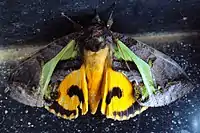 Female
Female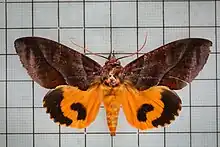 Male
Male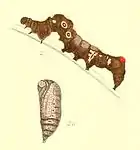 Caterpillar and pupa
Caterpillar and pupa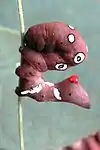 Caterpillar
Caterpillar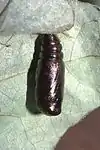 Pupa
Pupa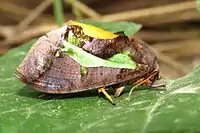 Adult lateral view
Adult lateral view
References
- "Eudocima homaena Hübner (1816)". India Biodiversity Portal. Retrieved 18 August 2016.
- "Eudocima homaena (Hubner)". Insects in Indian Agroecosystems. ICAR-National Bureau of Agricultural Insect Resources. Retrieved 18 August 2016.
- Hampson, G. F. (1894). The Fauna of British India, Including Ceylon and Burma: Moths Volume II. Taylor and Francis – via Biodiversity Heritage Library.
- "Eudocima [Othreis] homaena Hübner". The Moths of Borneo. Retrieved 18 August 2016.